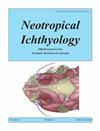Trophic ecology and resource partitioning of Haemulidae species along the Northeastern Brazilian continental shelf
IF 2
4区 生物学
Q1 ZOOLOGY
引用次数: 0
Abstract
Abstract In the Southeastern Tropical Atlantic, Haemulidae family play an important role both environmentally, acting as a link between lower and higher trophic levels, and socioeconomically, being widely caught by artisanal fleets. This study aimed to describe the trophic ecology of three grunt species (Haemulon aurolineatum, H. plumierii and H. squamipinna) considering spatial, temporal and ontogenetic aspects, integrating stomach content and stable isotopes analysis. Sampling occurred in 26 stations along the Northeast of Brazil (04°– 09°S), in August 2015 and April 2017, using bottom trawling net. There was greater feeding intensity at night, at latitudes below 08°S and in the inner continental shelf. Higher values of δ¹⁵N were reported for H. aurolineatum and H. plumierii collected near coastline. The isotopic niche breadth indicated that H. aurolineatum has a narrower diet thanH. plumierii. For the three species, the trophic level ranged between three and four. Considering stomach content and isotopic niche, diet was similar comparing species. This trophic ecology pattern reveals a likewise use of the habitat, which may be essential for identifying priority areas for conservation on an ecosystem basis, especially in rich reef zones that are subject to several increasing pressures, such as those in Northeast Brazil.巴西东北大陆架海蛭科物种的营养生态学和资源分配
在热带大西洋东南部,Haemulidae家族在环境和社会经济方面都发挥着重要作用,它们是连接低营养水平和高营养水平的纽带,被手工船队广泛捕获。本研究结合胃内容物和稳定同位素分析,从空间、时间和个体发生的角度对3种咕噜鱼(Haemulon aurolineatum, H. plumierii和H. squamipinna)的营养生态学进行了研究。2015年8月和2017年4月,使用底拖网在巴西东北部(04°- 09°S)的26个站点进行了采样。夜间、纬度低于08°S和内大陆架的取食强度较大。据报道,在海岸线附近采集的aurolineatum和plumierii的δ 1 5 N值较高。同位素生态位宽度表明,栉齿鼩的饮食比栉齿鼩窄。plumierii。这三个物种的营养等级在3级到4级之间。从胃内容物和同位素生态位的角度考虑,两种动物的日粮相似。这种营养生态模式揭示了栖息地的同样利用,这可能是在生态系统基础上确定优先保护区域的必要条件,特别是在受到几个日益增加的压力的丰富珊瑚礁区,例如巴西东北部的珊瑚礁区。
本文章由计算机程序翻译,如有差异,请以英文原文为准。
求助全文
约1分钟内获得全文
求助全文
来源期刊

Neotropical Ichthyology
生物-动物学
CiteScore
2.80
自引率
17.60%
发文量
24
审稿时长
6-12 weeks
期刊介绍:
Neotropical Ichthyology is the official journal of the Sociedade Brasileira de Ictiologia (SBI). It is an international peer-reviewed Open Access periodical that publishes original articles and reviews exclusively on Neotropical freshwater and marine fishes and constitutes an International Forum to disclose and discuss results of original research on the diversity of marine, estuarine and freshwater Neotropical fishes.
-Frequency: Four issues per year published only online since 2020, using the ‘rolling pass’ system, which posts articles online immediately as soon as they are ready for publication. A searchable and citable Digital Object Identifier (DOI) is assigned to each article immediately after online publication, with no need to await the issue’s closing.
-Areas of interest: Biology, Biochemistry and Physiology, Ecology, Ethology, Genetics and Molecular Biology, Systematics.
-Peer review process: The Editor-in-Chief screens each manuscript submitted to Neotropical Ichthyology to verify whether it is within the journal’s scope and policy, presents original research and follows the journal’s guidelines. After passing through the initial screening, articles are assigned to a Section Editor, who then assigns an Associate Editor to start the single blind review process.
 求助内容:
求助内容: 应助结果提醒方式:
应助结果提醒方式:


